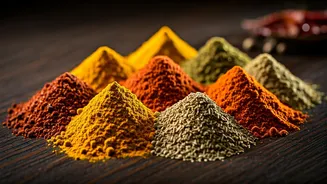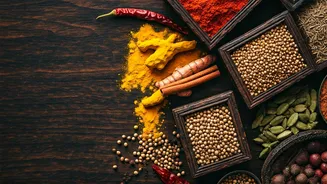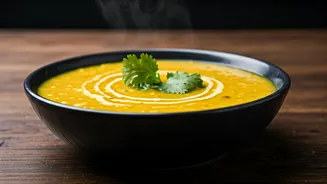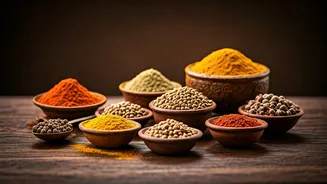History of Indian Cuisine
Indian cuisine boasts a rich history, with culinary practices evolving over thousands of years. Early influences came from the Indus Valley Civilization,
with evidence of wheat, barley, and sesame being cultivated. Over time, invasions and trade routes played a huge role, bringing in new ingredients and cooking methods, leading to an amalgamation of flavors. The Mughals, for example, brought with them a sophisticated style of cooking that emphasized rich gravies and the use of nuts and dried fruits. The British colonial period also left a mark, introducing new ingredients and adapting existing dishes. The result is a diverse and dynamic cuisine that varies greatly from region to region, representing a melting pot of cultures and traditions.
Essential Indian Spices
Spices form the very heart of Indian cooking, contributing depth, flavor, and color to various dishes. Turmeric, often called the 'golden spice,' is a cornerstone, known for its vibrant hue and health benefits. Cumin, both in its whole and ground forms, provides an earthy warmth. Coriander adds a citrusy note. Chili peppers, ranging from mild to intensely hot, provide the necessary heat. Garam masala, a complex blend of various spices, is often added towards the end of cooking to enhance the final flavor. The skillful use of these spices is what distinguishes Indian cuisine. It’s the art of balancing flavors to create a symphony of taste in every single bite.
Regional Culinary Variations
India's regional diversity is reflected in its vast range of cuisines. In the north, the focus is on wheat-based dishes like roti and paratha, with rich curries often using dairy products. The use of tandoor ovens is prominent. Moving south, rice becomes the staple, with dishes like dosa, idli, and sambar taking center stage. Coastal regions feature seafood prominently, using ingredients like coconut milk and fresh spices. Eastern Indian cuisine often incorporates the use of mustard oil and features both sweet and savory flavors, with dishes like rasgulla and fish curries. Western India showcases a blend of influences, with dishes that combine Gujarati sweetness, Maharashtrian spice, and Goan seafood.
Popular Street Food Delights
India's street food is a colorful and flavorful experience, reflecting the country's diverse culinary landscape. From the crispy, savory samosas and the tangy, flavorful chaats to the savory pav bhaji, each region has its own specialties. Mumbai's vada pav, Delhi's chole bhature, and Kolkata's puchkas (pani puri) are just a few examples. These street foods are not just snacks; they are integral parts of the local culture, often prepared and sold by generations of families. They provide an affordable and delicious way for people to experience the true flavors of India. They represent the vibrant social atmosphere and are a significant aspect of the culinary tradition.
Cooking Techniques Unveiled
Indian cooking uses a range of techniques, that enhance the flavors and textures of the dishes. Tandoor cooking, used mainly in northern India, involves grilling food in a clay oven at high temperatures, imparting a smoky flavor. Tempering, or tadka, is a method of infusing hot oil with spices to release their flavor before adding them to a dish. Grinding spices fresh, rather than using pre-ground powders, helps intensify the flavors. Slow cooking is common, allowing flavors to meld, creating tender meats and flavorful gravies. From the gentle art of tempering spices to the fast heat of the tandoor, these techniques play a vital role in crafting the deliciousness of Indian cuisine.
Cultural Significance of Food
Food plays a central role in Indian culture, representing more than mere sustenance. It marks celebrations, rituals, and the everyday experience. Traditional festivals involve special foods that celebrate seasons or religious events. Hospitality is greatly valued, and sharing food is a sign of welcome and respect. Family meals are crucial, promoting social bonding and passing down family recipes. Vegetarianism is widely practiced, often linked to religious beliefs. The choice of ingredients and methods of cooking reflect the values and traditions of different communities. Meals are frequently viewed as a spiritual exercise and a way of connecting with family, friends, and their cultural heritage.













